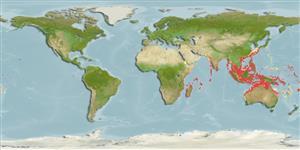Common names from other countries
>
Carangiformes (Jacks) >
Carangidae (Jacks and pompanos) > Caranginae
Etymology: Caranx: French, carangue, the name of a Caribbean fish; 1836 (Ref. 45335).
More on author: Cuvier.
Environment: milieu / climate zone / depth range / distribution range
Ecología
marino asociado a arrecife; rango de profundidad 30 - 120 m (Ref. 12260). Tropical; 35°N - 31°S, 32°E - 172°W
Indo-West Pacific: Zanzibar (Tanzania) to Durban (South Africa), Madagascar and Sri Lanka; north to Okinawa, Ryukyus, south to the Arafura Sea (Ref. 9819), Australia and Fiji. Distribution in the Indian Ocean not well established.
Tamaño / Peso / Age
Maturity: Lm ? range ? - ? cm
Max length : 80.0 cm TL macho / no sexado; (Ref. 3197); common length : 50.0 cm TL macho / no sexado; (Ref. 3280); peso máximo publicado: 7.2 kg (Ref. 40637)
Espinas dorsales (total) : 9; Radios blandos dorsales (total) : 20 - 22; Espinas anales: 3; Radios blandos anales: 16 - 18.
Adults inhabit coastal waters, near coral reefs and rocks. They feed on fish and crustaceans (Ref. 5213). Solitary or small groups are found in vicinity of reefs (Ref. 90102).
Life cycle and mating behavior
Maturities | Reproducción | Spawnings | Egg(s) | Fecundities | Larva
Paxton, J.R., D.F. Hoese, G.R. Allen and J.E. Hanley, 1989. Pisces. Petromyzontidae to Carangidae. Zoological Catalogue of Australia, Vol. 7. Australian Government Publishing Service, Canberra, 665 p. (Ref. 7300)
IUCN Red List Status (Ref. 130435)
CITES (Ref. 128078)
Not Evaluated
Threat to humans
Harmless
Human uses
Pesquerías: escaso valor comercial; pesca deportiva: si
Herramientas
Special reports
Download XML
Fuentes de Internet
Estimates based on models
Preferred temperature (Ref.
115969): 22.5 - 28.3, mean 27 (based on 580 cells).
Phylogenetic diversity index (Ref.
82804): PD
50 = 0.5000 [Uniqueness, from 0.5 = low to 2.0 = high].
Bayesian length-weight: a=0.01380 (0.00771 - 0.02471), b=2.99 (2.84 - 3.14), in cm Total Length, based on LWR estimates for this species & Genus-body shape (Ref.
93245).
Nivel trófico (Ref.
69278): 4.1 ±0.68 se; based on food items.
Resiliencia (Ref.
120179): Medio, población duplicada en un tiempo mínimo de 1.4-4.4 años (Preliminary K or Fecundity.).
Fishing Vulnerability (Ref.
59153): Moderate vulnerability (38 of 100).
